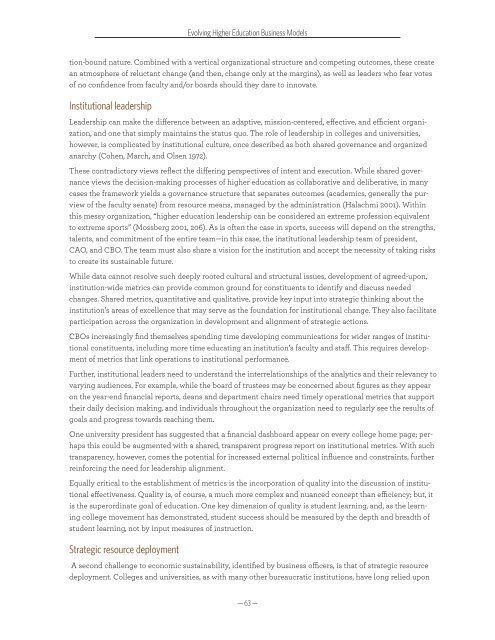Evolving Higher Education Business Models
Evolving-Higher-Education-Business-Models
Evolving-Higher-Education-Business-Models
Create successful ePaper yourself
Turn your PDF publications into a flip-book with our unique Google optimized e-Paper software.
<strong>Evolving</strong> <strong>Higher</strong> <strong>Education</strong> <strong>Business</strong> <strong>Models</strong><br />
tion-bound nature. Combined with a vertical organizational structure and competing outcomes, these create<br />
an atmosphere of reluctant change (and then, change only at the margins), as well as leaders who fear votes<br />
of no confidence from faculty and/or boards should they dare to innovate.<br />
Institutional leadership<br />
Leadership can make the difference between an adaptive, mission-centered, effective, and efficient organization,<br />
and one that simply maintains the status quo. The role of leadership in colleges and universities,<br />
however, is complicated by institutional culture, once described as both shared governance and organized<br />
anarchy (Cohen, March, and Olsen 1972).<br />
These contradictory views reflect the differing perspectives of intent and execution. While shared governance<br />
views the decision-making processes of higher education as collaborative and deliberative, in many<br />
cases the framework yields a governance structure that separates outcomes (academics, generally the purview<br />
of the faculty senate) from resource means, managed by the administration (Halachmi 2001). Within<br />
this messy organization, “higher education leadership can be considered an extreme profession equivalent<br />
to extreme sports” (Mossberg 2001, 206). As is often the case in sports, success will depend on the strengths,<br />
talents, and commitment of the entire team—in this case, the institutional leadership team of president,<br />
CAO, and CBO. The team must also share a vision for the institution and accept the necessity of taking risks<br />
to create its sustainable future.<br />
While data cannot resolve such deeply rooted cultural and structural issues, development of agreed-upon,<br />
institution-wide metrics can provide common ground for constituents to identify and discuss needed<br />
changes. Shared metrics, quantitative and qualitative, provide key input into strategic thinking about the<br />
institution’s areas of excellence that may serve as the foundation for institutional change. They also facilitate<br />
participation across the organization in development and alignment of strategic actions.<br />
CBOs increasingly find themselves spending time developing communications for wider ranges of institutional<br />
constituents, including more time educating an institution’s faculty and staff. This requires development<br />
of metrics that link operations to institutional performance.<br />
Further, institutional leaders need to understand the interrelationships of the analytics and their relevancy to<br />
varying audiences. For example, while the board of trustees may be concerned about figures as they appear<br />
on the year-end financial reports, deans and department chairs need timely operational metrics that support<br />
their daily decision making, and individuals throughout the organization need to regularly see the results of<br />
goals and progress towards reaching them.<br />
One university president has suggested that a financial dashboard appear on every college home page; perhaps<br />
this could be augmented with a shared, transparent progress report on institutional metrics. With such<br />
transparency, however, comes the potential for increased external political influence and constraints, further<br />
reinforcing the need for leadership alignment.<br />
Equally critical to the establishment of metrics is the incorporation of quality into the discussion of institutional<br />
effectiveness. Quality is, of course, a much more complex and nuanced concept than efficiency; but, it<br />
is the superordinate goal of education. One key dimension of quality is student learning, and, as the learning<br />
college movement has demonstrated, student success should be measured by the depth and breadth of<br />
student learning, not by input measures of instruction.<br />
Strategic resource deployment<br />
A second challenge to economic sustainability, identified by business officers, is that of strategic resource<br />
deployment. Colleges and universities, as with many other bureaucratic institutions, have long relied upon<br />
— 63 —


